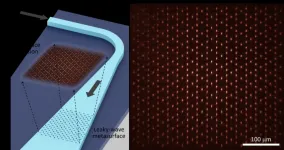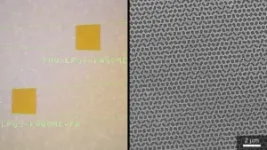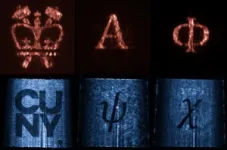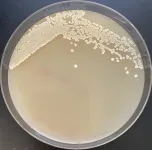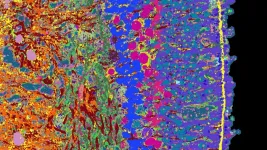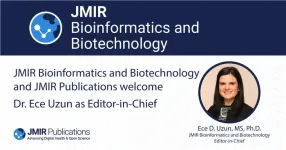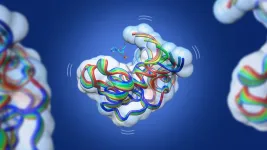(Press-News.org) New York, NY—May 8, 2023—Researchers at Columbia Engineering have developed a new class of integrated photonic devices--“leaky-wave metasurfaces”--that can convert light initially confined in an optical waveguide to an arbitrary optical pattern in free space. These devices are the first to demonstrate simultaneous control of all four optical degrees of freedom, namely, amplitude, phase, polarization ellipticity, and polarization orientation--a world record. Because the devices are so thin, transparent, and compatible with photonic integrated circuits (PICs), they can be used to improve optical displays, LIDAR (Light Detection and Ranging), optical communications, and quantum optics.
“We are excited to find an elegant solution for interfacing free-space optics and integrated photonics--these two platforms have traditionally been studied by investigators from different subfields of optics and have led to commercial products addressing completely different needs,” said Nanfang Yu, associate professor of applied physics and applied mathematics who is a leader in research on nanophotonic devices. “Our work points to new ways to create hybrid systems that utilize the best of both worlds--free-space optics for shaping the wavefront of light and integrated photonics for optical data processing--to address many emerging applications such as quantum optics, optogenetics, sensor networks, inter-chip communications, and holographic displays.”
Bridging free-space optics and integrated photonics
The key challenge of interfacing PICs and free-space optics is to transform a simple waveguide mode confined within a waveguide--a thin ridge defined on a chip--into a broad free-space wave with a complex wavefront, and vice versa. Yu’s team tackled this challenge by building on their invention last fall of “nonlocal metasurfaces” and extended the devices’ functionality from controlling free-space light waves to controlling guided waves.
Specifically, they expanded the input waveguide mode by using a waveguide taper into a slab waveguide mode--a sheet of light propagating along the chip. “We realized that the slab waveguide mode can be decomposed into two orthogonal standing waves--waves reminiscent of those produced by plucking a string,” said Heqing Huang, a PhD student in Yu’s lab and co-first author of the study, published today in Nature Nanotechnology. “Therefore, we designed a ‘leaky-wave metasurface’ composed of two sets of rectangular apertures that have a subwavelength offset from each other to independently control these two standing waves. The result is that each standing wave is converted into a surface emission with independent amplitude and polarization; together, the two surface emission components merge into a single free-space wave with completely controllable amplitude, phase, and polarization at each point over its wavefront.”
From quantum optics to optical communications to holographic 3D displays
Yu’s team experimentally demonstrated multiple leaky-wave metasurfaces that can convert a waveguide mode propagating along a waveguide with a cross-section on the order of one wavelength into free-space emission with a designer wavefront over an area about 300 times the wavelength at the telecom wavelength of 1.55 microns. These include:
A leaky-wave metalens that produces a focal spot in free space. Such a device will be ideal for forming a low-loss, high-capacity free-space optical link between PIC chips; it will also be useful for an integrated optogenetic probe that produces focused beams to optically stimulate neurons located far away from the probe.
A leaky-wave optical-lattice generator that can produce hundreds of focal spots forming a Kagome lattice pattern in free space. In general, the leaky-wave metasurface can produce complex aperiodic and three-dimensional optical lattices to trap cold atoms and molecules. This capability will enable researchers to study exotic quantum optical phenomena or conduct quantum simulations hitherto not easily attainable with other platforms, and enable them to substantially reduce the complexity, volume, and cost of atomic-array-based quantum devices. For example, the leaky-wave metasurface could be directly integrated into the vacuum chamber to simplify the optical system, making portable quantum optics applications, such as atomic clocks, a possibility.
A leaky-wave vortex-beam generator that produces a beam with a corkscrew-shaped wavefront. This could lead to a free-space optical link between buildings that relies on PICs to process information carried by light, while also using light waves with shaped wavefronts for high-capacity intercommunication.
A leaky-wave hologram that can displace four distinct images simultaneously: two at the device plane (at two orthogonal polarization states) and another two at a distance in the free space (also at two orthogonal polarization states). This function could be used to make lighter, more comfortable augmented reality goggles and more realistic holographic 3D displays.
Device fabrication
Device fabrication was carried out at the Columbia Nano Initiative cleanroom, and at the Advanced Science Research Center NanoFabrication Facility at the Graduate Center of the City University of New York.
Next steps
Yu’s current demonstration is based on a simple polymer-silicon nitride materials platform at near-infrared wavelengths. His team plans next to demonstrate devices based on the more robust silicon nitride platform, which is compatible with foundry fabrication protocols and tolerant to high optical power operation. They also plan to demonstrate designs for high output efficiency and operation at visible wavelengths, which is more suitable for applications such as quantum optics and holographic displays.
###
About the Study
Journal: Nature Nanotechnology
The study is titled “Leaky-wave metasurfaces for integrated photonics.”
Authors are: Heqing Huang1,†, Adam C. Overvig1,2,†, Yuan Xu1, Stephanie C. Malek1, Cheng-Chia Tsai1, Andrea Alù2,3,*, and Nanfang Yu1,*
1Department of Applied Physics and Applied Mathematics, Columbia University
2Photonics Initiative, Advanced Science Research Center, City University of New York
3Physics Program, Graduate Center, City University of New York
†Authors contributed equally
*Corresponding authors
The study was supported by the National Science Foundation (grant no. QII-TAQS-1936359 (H.H., Y.X., and N.Y.) and no. ECCS-2004685 (S.C.M., C.-C.T., and N.Y.)), the Air Force Office of Scientific Research (no. FA9550-16-1-0322 (N.Y.)), and the Simons Foundation (A.C.O. and A.A). S.C.M. acknowledges support from the NSF Graduate Research Fellowship Program (grant no. DGE-1644869).
A.C.O., S.C.M., and N.Y. are listed as inventors in a US non-provisional patent application no. 17/110,846; in addition, H.H., Y.X., A.C.O., A.A., and N.Y. are listed as inventors in a US provisional application no. 63/342,475. Both were filed by Columbia University and are related to the technology reported in this article. The remaining authors declare no competing interests.
###
LINKS:
Paper: https://www.nature.com/articles/s41565-023-01360-z
DOI: 10.1038/s41565-023-01360-z
###
END
Leaky-wave metasurfaces: A perfect interface between free-space and integrated optical systems
New class of integrated nanophotonic devices--a world record in simultaneous control of all four optical degrees of freedom--can convert light initially confined in an optical waveguide to an arbitrary optical pattern in free space.
2023-05-08
ELSE PRESS RELEASES FROM THIS DATE:
AI predicts future pancreatic cancer
2023-05-08
An artificial intelligence tool has successfully identified people at the highest risk for pancreatic cancer up to three years before diagnosis using solely the patients’ medical records, according to new research led by investigators at Harvard Medical School and the University of Copenhagen, in collaboration with VA Boston Healthcare System, Dana-Farber Cancer Institute, and the Harvard T.H. Chan School of Public Health.
The findings, published May 8 in Nature Medicine, suggest that AI-based population screening could be valuable in finding those at elevated risk for the disease and could expedite the diagnosis of a condition ...
Tiny microbes could brew big benefits for green biomanufacturing
2023-05-08
A research team led by Lawrence Berkeley National Laboratory (Berkeley Lab) and UC Berkeley has engineered bacteria to produce new-to-nature carbon products that could provide a powerful route to sustainable biochemicals.
The advance – which was recently announced in the journal Nature – uses bacteria to combine natural enzymatic reactions with a new-to-nature reaction called the “carbene transfer reaction.” This work could also one day help reduce industrial emissions because it offers sustainable ...
Human Brain Project: Study presents large brain-like neural networks for AI
2023-05-08
In a new study in Nature Machine Intelligence*, researchers Bojian Yin and Sander Bohté from the HBP partner Dutch National Research Institute for Mathematics and Computer Science (CWI) demonstrate a significant step towards artificial intelligence that can be used in local devices like smartphones and in VR-like applications, while protecting privacy. They show how brain-like neurons combined with novel learning methods enable training fast and energy-efficient spiking neural networks on a large scale. Potential applications range from wearable AI to speech recognition and Augmented Reality.
While modern artificial neural ...
Detailed image of the human retina
2023-05-08
What cell types are found in which human tissue, and where? Which genes are active in the individual cells, and which proteins are found there? Answers to these questions and more are to be provided by a specialised atlas – in particular how the different tissues form during embryonic development and what causes diseases. In creating this atlas, researchers aim to map not only tissue directly isolated from humans, but also structures called organoids. These are three-dimensional clumps of tissue that are cultivated in the laboratory and develop in a way similar ...
Welcoming Dr Ece Uzun, MS, PhD as the Editor-in-Chief for JMIR Bioinformatics and Biotechnology
2023-05-08
JMIR Bioinformatics and Biotechnology and JMIR Publications are thrilled to announce and welcome Dr Ece Uzun as Editor-in-Chief for JMIR Bioinformatics and Biotechnology.
Dr. Uzun is currently the Director of Clinical Bioinformatics and Associate Director of Clinical Cancer Informatics and Data Science (CCIDS) at Lifespan and an Assistant Professor of Pathology and Laboratory Medicine at Brown University Alpert Medical School. She has a B.S in Chemical Engineering and M.Sc in Biological Sciences and Bioengineering. She completed her PhD in Chemical Engineering at Northeastern University in 2010 and focused ...
Elucidating the mysteries of enzyme evolution at the macromolecular level
2023-05-08
Professor Nicolas Doucet and his team at Institut national de la recherche scientifique (INRS) made a major breakthrough earlier this year in the field of evolutionary conservation of molecular dynamics in enzymes. Their work, published in the journal Structure, points to potential applications in health, including the development of new drugs to treat serious diseases such as cancer or to counter antibiotic resistance.
As a researcher specializing in protein dynamics, Professor Doucet is captivated by things that are invisible to the naked eye, yet full of mysteries and essential to all forms of life. He studies proteins ...
Recent research advances on historical artifacts and their preservation
2023-05-08
Because we don’t have crystal balls to show us how the world used to look, scientists must rely on preserved artifacts and specimens to provide the details. Below are some recent papers published in ACS journals that have unearthed insights from historic items and provided suggestions for protecting relics. Reporters can request free access to these papers by emailing newsroom@acs.org.
“Two Pathways for the Degradation of Orpiment Pigment (As2S3) Found in Paintings”
Journal of the American Chemical Society
April 14, 2023
Oil paintings created before the 19th century often ...
Chinese Medical Journal review highlights the health hazards of air pollution
2023-05-08
Globally, air pollution is a major public health hazard. A key air pollutant linked to health risks is ambient fine particulate matter (PM2.5), which consists of minute particles, sized less than or equal to 2.5 μm, suspended in the air. According to the WHO, annual PM2.5 levels should not exceed 5 μg/m3. However, the current PM2.5 levels in China far exceed this standard and are responsible for approximately 1.4 million PM2.5-related excess deaths annually. Even as the country steadily works towards reducing ...
Researchers Identify the Standard for Gallbladder Cancer Surgery
2023-05-08
(Boston)—The quality of surgery can drastically influence both short- and long-term postoperative outcomes and is a crucial consideration in studies that assess surgical outcomes. One approach for developing accurate quality measures is benchmarking, a quality-improvement process in which the best possible outcomes are identified to serve as a point of reference against which performance can be compared.
Surgery for gallbladder cancer (GBC) is a technically challenging surgical procedure and requires considerable expertise ...
Mathematical model based on psychology predicts who will buy trendy products
2023-05-08
It’s often risky to introduce new products to the market. In fact, statistics show that between 40 to 90 percent of new products fail. A key component of product adoption is consumer psychology. While there are a few theories that attempt to explain why certain people are not likely to accept novelties, a new study takes a slightly different approach.
Florida Atlantic University and collaborators developed and introduced a new mathematical innovation model, grounded in psychology, to provide both qualitative and quantitative predictions of adoption trends for new products.
The objective of the study ...
LAST 30 PRESS RELEASES:
B cells transiently unlock their plasticity, risking lymphoma development
Advanced AI dodel predicts spoken language outcomes in deaf children after cochlear implants
Multimodal imaging-based cerebral blood flow prediction model development in simulated microgravity
Accelerated streaming subgraph matching framework is faster, more robust, and scalable
Gestational diabetes rose every year in the US since 2016
OHSU researchers find breast cancer drug boosts leukemia treatment
Fear and medical misinformation regarding risk of progression or recurrence among patients with breast cancer
Glucagonlike peptide-1 receptor agonists and asthma risk in adolescents with obesity
Reviving dormant immunity: Millimeter waves reprogram the immunosuppressive microenvironment to potentiate immunotherapy without obvious side effects
Safety decision-making for autonomous vehicles integrating passenger physiological states by fNIRS
Fires could emit more air pollution than previously estimated
A new way to map how cells choose their fate
Numbers in our sights affect how we perceive space
SIMJ announces global collaborative book project in commemoration of its 75th anniversary
Air pollution exposure and birth weight
Obstructive sleep apnea risk and mental health conditions among older adults
How talking slows eye movements behind the wheel
The Ceramic Society of Japan’s Oxoate Ceramics Research Association launches new international book project
Heart-brain connection: international study reveals the role of the vagus nerve in keeping the heart young
Researchers identify Rb1 as a predictive biomarker for a new therapeutic strategy in some breast cancers
Survey reveals ethical gaps slowing AI adoption in pediatric surgery
Stimulant ADHD medications work differently than thought
AI overestimates how smart people are, according to HSE economists
HSE researchers create genome-wide map of quadruplexes
Scientists boost cell "powerhouses" to burn more calories
Automatic label checking: The missing step in making reliable medical AI
Low daily alcohol intake linked to 50% heightened mouth cancer risk in India
American Meteorological Society announces Rick Spinrad as 2026 President-Elect
Biomass-based carbon capture spotlighted in newly released global climate webinar recording
Illuminating invisible nano pollutants: advanced bioimaging tracks the full journey of emerging nanoscale contaminants in living systems
[Press-News.org] Leaky-wave metasurfaces: A perfect interface between free-space and integrated optical systemsNew class of integrated nanophotonic devices--a world record in simultaneous control of all four optical degrees of freedom--can convert light initially confined in an optical waveguide to an arbitrary optical pattern in free space.
